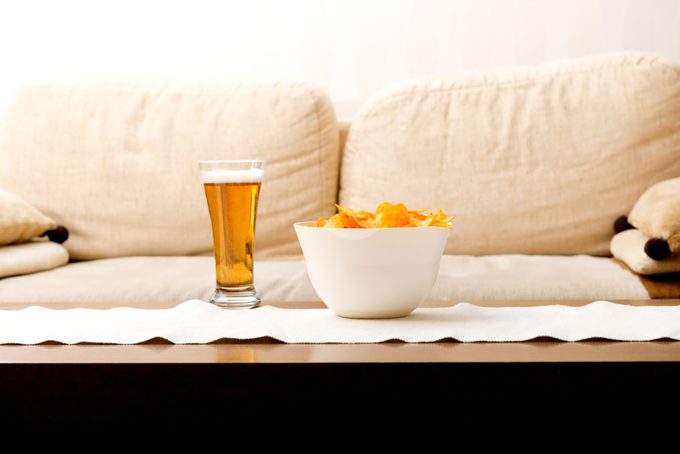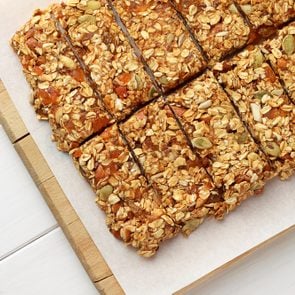Did You Gain Weight During the Quarantine? 10 Expert Weight-Loss Solutions
Updated: Mar. 14, 2022
Many Americans added pounds during the pandemic, resulting in the "quarantine 15"—weight gain during lockdown. Here's how to eat healthier to lose weight.
Quarantine weight gain
Life during coronavirus continues to be a challenge for a lot of reasons. Stay-at-home orders mean hunkering down at home with limited options for entertainment, socializing, or exercising. On the other hand, we have plenty of time to bake, cook, snack, and eat. If you turned to food for comfort during the Covid-19 pandemic, you weren’t alone. A new survey by biotech company Gelesis found that 71 million Americans report having gained weight during the pandemic, which helps explain the term “quarantine 15”. (Here’s how to avoid emotional eating during coronavirus.)
“When we go to our office or place of work, we tend to follow a set eating schedule: Maybe we eat breakfast before we leave for work, have a snack mid-morning and mid-afternoon, have lunch at noon, and then fix dinner once we get home,” explains Roger Adams, a personal trainer, doctor of nutrition, and owner of eatrightfitness.com.
“With set schedules blurred, we may find ourselves grazing or eating mindlessly all day long which can easily cause us to over-consume calories or simply eat more than we need,” he says. (These are the best stress-reducing foods.)
When you tack on the excesses of the holiday season, from Halloween through New Year’s, it can be quite the recipe for weight gain. The good news: Even if you put on a few (or a lot) more pounds than you would have liked in 2020, there are several healthy solutions for shedding the weight this new year. Here are some expert strategies to lose weight with sensible eating and exercise.

Understand your “why”
If a client wants to lose weight, the first step is for them to ask themselves why this goal is important, says Katrina Pilkington, a certified personal trainer and certified nutrition coach in Tampa Bay, Florida.
“Is weight loss an initial step to combating chronic health issues or results from a medical assessment, or is there an element of self-confidence that someone is looking to gain by meeting some sort of physical aesthetic to conform to societal norms?” she asks. “The ultimate goals are those that relate to the betterment of a person’s life holistically,” she says.
(These are the diet changes to help you lose weight.)
Start off with a reasonable goal
If you make the commitment to lose weight, it’s important that you start off with a reasonable goal. Adams recommends beginning with no more than one to two pounds per month, and only weighing yourself twice per week at the same time of the day each time. A slow, steady approach is the best way to make changes that fit your lifestyle and achieve goals that you can truly maintain.
“I usually recommend Wednesdays and Saturdays as this gives you an idea of patterns and habits during the week and weekend,” he says. “If you don’t have much weight to lose, then one to two pounds per month is not reasonable and you should check with an expert and find out what a healthy weight for you should be,” Adams says. (These self-motivation quotes can help you achieve your goals.)
Quit counting calories
Calorie counting is one of the oldest weight loss tricks in the trade, but Nadia Murdock, founder of Nadia Murdock Fit and Mindset and Movement Expert, warns that it can sometimes do more harm than good.
“Calorie counting can actually be counterproductive and create mental strain, fostering additional health problems,” she says. “With the practice of intuitive eating on the rise and focusing on portion control, many are recognizing healthier ways to enjoy food,” she explains. (Learn how calorie count in food is determined.)
Commit to an exercise routine
While exercise alone is not a good way to lose weight, Adams believes it is the best way to keep the weight from coming back. “Exercise is a great way for the body to adjust to your lighter weight,” he says. He recommends incorporating 200 to 300 minutes of exercise weekly (30 to 50 minutes, six days a week) to help your body keep the weight off from your dieting efforts. (These are the best workouts for people who hate exercise.)
Add more fiber to your diet
Adams recommends eating 25 grams of fiber or more per day. “Foods that are typically high in fiber, such as beans, cruciferous [vegetables], and fruits, are loaded in nutrients but lower in calories.” Focusing on these foods won’t leave room for a lot of empty or high-calorie snacks. (Here’s how to increase fiber in your diet.)
Start a mindful meal log
Laura Cipullo, RD and founder of Laura Cipullo Whole Nutrition + Yoga in New York City and New Jersey, recommends keeping track of where, when, why, what, and how you eat. “Be curious about what foods fill you and provide even amounts of energy throughout the day,” Cipullo says. “When engaging in the how to eat, use all five senses: taste, touch, sight, smell, and sound,” she says.
Combine all three macronutrients at mealtimes
Cipullo recommends incorporating carbohydrates, proteins, and fats into each meal. “Combining protein and fat with a carbohydrate, such as pasta or bread, will slow the absorption of the entire meal and result in a slower and lower blood sugar,” she says. “This will ultimately help you stay full longer, avoid any feelings of deprivation, and help prevent diabetes,” she explains.
Don’t worry about what everyone else is doing
Every time you sign onto social media, you’re probably bombarded by a new wellness product, workout, technique, diet, or program. This, Murdock warns, can be overwhelming and leave you feeling lost and possibly selecting an avenue that is not right for you.
“The Keto diet, for example, is an excellent program but it might not be the right one you are looking for,” she says. “Don’t be easily sucked into the excessive marketing of products and social media that may suggest it’s the way to go; just because something is trending doesn’t automatically mean that it’s the answer for you,” she explains.
Find ways to incorporate more activity during your day
Fitting in a workout is not always feasible, but sneaking in brief bouts of exercise throughout your day is more doable. Adams advises all his clients to follow his 6/60 rule: standing or moving for six minutes every 60 minutes of the workday. “We can’t all work out for hours a day, but we can find six minutes every hour to move more,” he says. (Here are secrets from women who exercise every day.)
Focus on foods that satisfy you
Cipullo recommends choosing foods that psychologically satisfy you and physically fill you up, which usually require fiber and protein. “We all know that deprivation leads to overeating, so consider having a smaller amount of the real thing to still feel satisfied from forbidden foods, such as your favorite cookies, with filling foods such as a sandwich or salmon with quinoa,” she adds.
Next, check out these weight loss before and after photos for inspiration.



